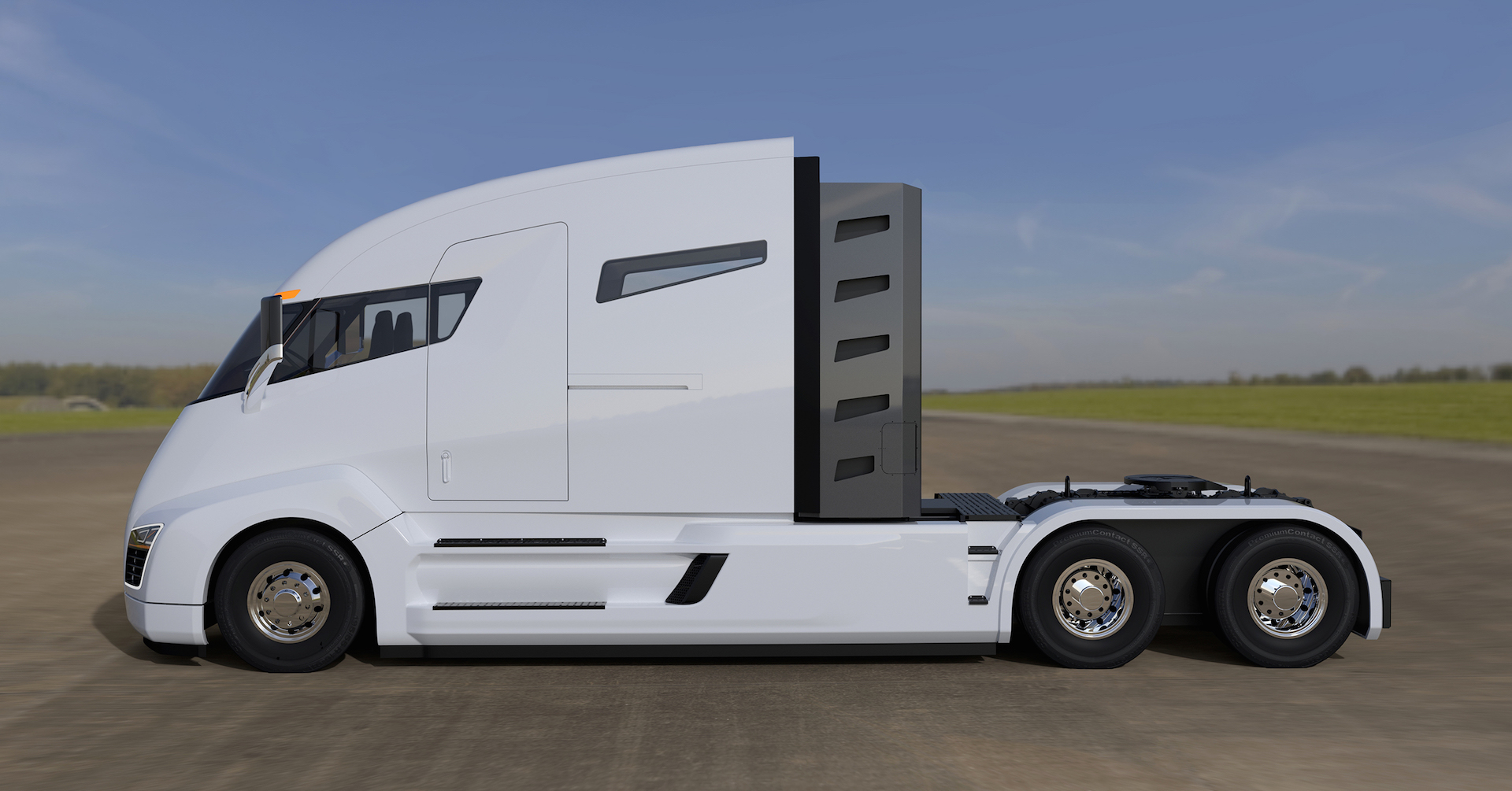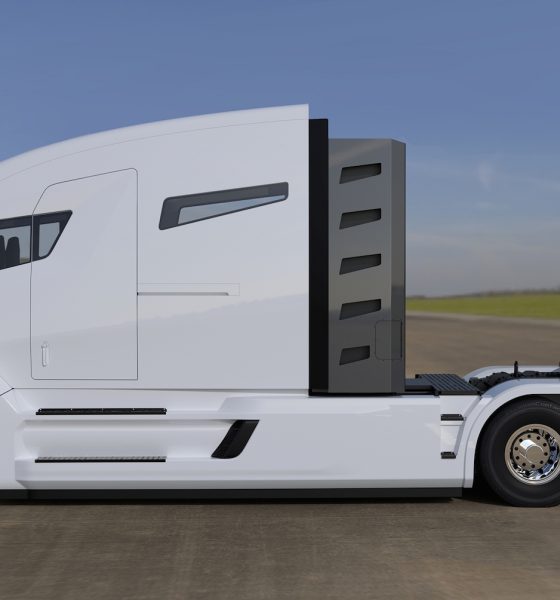

News
The Tesla Semi will shake the trucking industry to its roots
Elon Musk’s new Master Plan calls for an expansion of its vehicles into other categories, including buses and heavy duty trucks, both of which will unveiled in about a year. Undoubtedly, carbon emissions worldwide would fall precipitously if the general automobile consumer transitioned to a tailpipe-free electric Tesla, but that’s not what Elon Musk is after. His goal is a full frontal assault on carbon emissions of all kinds including a Tesla Semi. His objective is for nothing less than a world that no longer uses fossil fuels to power its transportation system, even on a commercial scale.
Looking back at the Volkswagen diesel scandal and why it was significant, beyond morality, diesel engines especially heavy-duty diesel trucks spew emissions on another level. To make the problem worse, passenger cars normally have a useful life of around 200,000 miles. Diesel powered tractors can be on the road for a decade or more, spewing out toxins for millions of miles before they are replaced. The pollution control systems on older trucks are rudimentary at best.
In Southern California, the pollution from drayage trucks that haul shipping containers from ports to inland distribution centers is so bad, it has sparked a number of plans to replace them with electric versions. One solution proposed by Siemens calls for equipping trucks with pantographs so they can draw electricity from overhead wires along their routes.
Former Tesla executive Ian Wright sold his stock in Tesla Motors when Elon Musk came on board. Wright wanted to attack the challenges of truck pollution rather than build some silly sports car. He has since created his own company called Wrightspeed that focuses on cleaning up the emissions from heavy duty garbage trucks. He has invented a new form of hybrid powertrain that uses a small gas turbine to recharge the batteries. The turbine is so clean, it doesn’t even need a catalytic converter to meet California’s stringent emissions rules.
The problem with electric trucks today is that the batteries need to be so large and heavy they would take up much of the space available for hauling freight. Not only that, they would be prohibitively expensive. The Wrightspeed system is a compromise that attempts to strike a balance between cost and range. It has attracted international attention and the company has recently signed a contract to re-power a fleet of diesel buses in New Zealand.
The allure of electric trucks has created an opportunity for hucksters and charlatans. Earlier this year, a Florida company calling itself Oakridge Global Energy Solutions said it had developed a battery for Freedom Trucking of Minneapolis that would haul an 80,000 lb. load 400 miles. That claim turned out to be vaporware.
Another entrant into the heavy truck sweepstakes is a company calling itself Nikola Motors — a rather obvious attempt to somehow conflate what it is doing with the work of Tesla Motors. It says its Nikola One tractor will have 2,000 horsepower. 3,700 lb-ft of torque, a 325 kWh battery, 6 wheel drive with torque vectoring and 1,200 miles of range. It relies on an onboard natural gas turbine to keep the battery charged while driving.
The design concept for the Nikola One is visually appealing and the company says it has 7,000 pre-orders for the truck worth a total of $2.3 billion. Of course, it currently has no factory, no battery factory, and little corporate infrastructure other than its website.
We can assume the Tesla Semi will not have a range extender engine of any type. How Tesla will make an electric tractor that can haul heavy loads long distances that is cost competitive remains unclear. But if Elon says that’s what Tesla will do, we can be pretty sure it will — eventually.
JB Straubel says he and Elon talked about electric airplanes long before they decided to build automobiles. And ocean going cargo vessels are some of the worst polluters on the face of the planet. Musk probably has a plan for them, too. Look for those ideas to be part of Master Plan Numero Tres.

News
Tesla FSD fleet is nearing 7 billion total miles, including 2.5 billion city miles
As can be seen on Tesla’s official FSD webpage, vehicles equipped with the system have now navigated over 6.99 billion miles.

Tesla’s Full Self-Driving (Supervised) fleet is closing in on almost 7 billion total miles driven, as per data posted by the company on its official FSD webpage.
These figures hint at the massive scale of data fueling Tesla’s rapid FSD improvements, which have been quite notable as of late.
FSD mileage milestones
As can be seen on Tesla’s official FSD webpage, vehicles equipped with the system have now navigated over 6.99 billion miles. Tesla owner and avid FSD tester Whole Mars Catalog also shared a screenshot indicating that from the nearly 7 billion miles traveled by the FSD fleet, more than 2.5 billion miles were driven inside cities.
City miles are particularly valuable for complex urban scenarios like unprotected turns, pedestrian interactions, and traffic lights. This is also the difference-maker for FSD, as only complex solutions, such as Waymo’s self-driving taxis, operate similarly on inner-city streets. And even then, incidents such as the San Francisco blackouts have proven challenging for sensor-rich vehicles like Waymos.
Tesla’s data edge
Tesla has a number of advantages in the autonomous vehicle sector, one of which is the size of its fleet and the number of vehicles training FSD on real-world roads. Tesla’s nearly 7 billion FSD miles then allow the company to roll out updates that make its vehicles behave like they are being driven by experienced drivers, even if they are operating on their own.
So notable are Tesla’s improvements to FSD that NVIDIA Director of Robotics Jim Fan, after experiencing FSD v14, noted that the system is the first AI that passes what he described as a “Physical Turing Test.”
“Despite knowing exactly how robot learning works, I still find it magical watching the steering wheel turn by itself. First it feels surreal, next it becomes routine. Then, like the smartphone, taking it away actively hurts. This is how humanity gets rewired and glued to god-like technologies,” Fan wrote in a post on X.
News
Tesla starts showing how FSD will change lives in Europe
Local officials tested the system on narrow country roads and were impressed by FSD’s smooth, human-like driving, with some calling the service a game-changer for everyday life in areas that are far from urban centers.

Tesla has launched Europe’s first public shuttle service using Full Self-Driving (Supervised) in the rural Eifelkreis Bitburg-Prüm region of Germany, demonstrating how the technology can restore independence and mobility for people who struggle with limited transport options.
Local officials tested the system on narrow country roads and were impressed by FSD’s smooth, human-like driving, with some calling the service a game-changer for everyday life in areas that are far from urban centers.
Officials see real impact on rural residents
Arzfeld Mayor Johannes Kuhl and District Administrator Andreas Kruppert personally tested the Tesla shuttle service. This allowed them to see just how well FSD navigated winding lanes and rural roads confidently. Kruppert said, “Autonomous driving sounds like science fiction to many, but we simply see here that it works totally well in rural regions too.” Kuhl, for his part, also noted that FSD “feels like a very experienced driver.”
The pilot complements the area’s “Citizen Bus” program, which provides on-demand rides for elderly residents who can no longer drive themselves. Tesla Europe shared a video of a demonstration of the service, highlighting how FSD gives people their freedom back, even in places where public transport is not as prevalent.
What the Ministry for Economic Affairs and Transport says
Rhineland-Palatinate’s Minister Daniela Schmitt supported the project, praising the collaboration that made this “first of its kind in Europe” possible. As per the ministry, the rural rollout for the service shows FSD’s potential beyond major cities, and it delivers tangible benefits like grocery runs, doctor visits, and social connections for isolated residents.
“Reliable and flexible mobility is especially vital in rural areas. With the launch of a shuttle service using self-driving vehicles (FSD supervised) by Tesla in the Eifelkreis Bitburg-Prüm, an innovative pilot project is now getting underway that complements local community bus services. It is the first project of its kind in Europe.
“The result is a real gain for rural mobility: greater accessibility, more flexibility and tangible benefits for everyday life. A strong signal for innovation, cooperation and future-oriented mobility beyond urban centers,” the ministry wrote in a LinkedIn post.
News
Tesla China quietly posts Robotaxi-related job listing
Tesla China is currently seeking a Low Voltage Electrical Engineer to work on circuit board design for the company’s autonomous vehicles.

Tesla has posted a new job listing in Shanghai explicitly tied to its Robotaxi program, fueling speculation that the company is preparing to launch its dedicated autonomous ride-hailing service in China.
As noted in the listing, Tesla China is currently seeking a Low Voltage Electrical Engineer to work on circuit board design for the company’s autonomous vehicles.
Robotaxi-specific role
The listing, which was shared on social media platform X by industry watcher @tslaming, suggested that Tesla China is looking to fill the role urgently. The job listing itself specifically mentions that the person hired for the role will be working on the Low Voltage Hardware team, which would design the circuit boards that would serve as the nervous system of the Robotaxi.
Key tasks for the role, as indicated in the job listing, include collaboration with PCB layout, firmware, mechanical, program management, and validation teams, among other responsibilities. The role is based in Shanghai.
China Robotaxi launch
China represents a massive potential market for robotaxis, with its dense urban centers and supportive policies in select cities. Tesla has limited permission to roll out FSD in the country, though despite this, its vehicles have been hailed as among the best in the market when it comes to autonomous features. So far, at least, it appears that China supports Tesla’s FSD and Robotaxi rollout.
This was hinted at in November, when Tesla brought the Cybercab to the 8th China International Import Expo (CIIE) in Shanghai, marking the first time that the autonomous two-seater was brought to the Asia-Pacific region. The vehicle, despite not having a release date in China, received a significant amount of interest among the event’s attendees.








